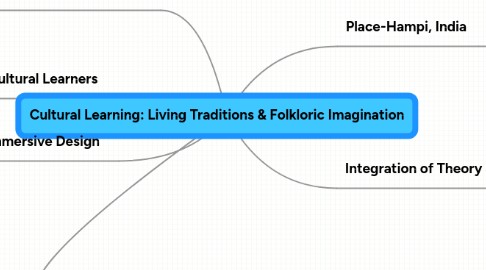
1. Cross-cultural Learners
1.1. Pilgrims
1.2. Observers
2. Basis of Immersive Design
2.1. Immersive Archaeology
2.1.1. Hermeneutics
2.1.2. Phenomenology
2.1.3. Re-enactment
2.1.4. Embodiment
3. Mediation
3.1. Innovative immersive technologies
3.1.1. Stereoscopic panoramas
3.1.2. Aural fields
3.1.3. Computer graphics
3.1.3.1. Animations of dieties
3.1.4. Co-actions & narratives
3.1.4.1. Interactive
3.1.4.2. Dynamic
3.1.5. Embedded knowledge
3.1.5.1. Cultural Narratives
3.1.5.1.1. Myths
3.1.5.1.2. Legends
3.1.5.2. Aesthetics of engagement
3.1.5.2.1. Iconography
3.1.5.2.2. Magic Realism
3.1.6. AVIE environment
3.1.6.1. Public dissemination
3.1.6.2. Communication
3.1.6.2.1. Sensory
3.1.6.2.2. Somatic
3.1.6.2.3. Corpothetic
4. Immersive experience
4.1. Theater of Participation
4.1.1. Landscapes
4.1.1.1. Archaeological
4.1.1.2. Historic
4.1.1.3. Cultural
4.1.2. Kinesthetic
4.1.2.1. Physical
4.1.2.2. Sensory
4.1.3. Presence
4.1.3.1. Illusion of non-mediation
4.1.3.2. Feeling of "being there"
5. Place-Hampi, India
5.1. Hindu pilgrimage site
5.1.1. Temple Complex
5.1.2. Tangible
5.2. Kingdom of Monkeys
5.2.1. Religious Experience
5.2.2. Intangible
6. Integration of Theory & Practice
6.1. Symmetrical Archaeology
6.1.1. Past/present
6.1.1.1. Historic Place
6.1.1.2. Active pilgrimage site
6.1.2. Meaning/referent
6.1.2.1. Myths and Legends
6.1.2.2. Cultural memory
6.1.3. Subject/object
6.1.3.1. Pilgrims-seeing
6.1.3.2. Dieties-being seen
6.1.4. Representation/represented
6.1.4.1. Dialogues of engagement
6.1.5. Things/people
6.1.5.1. Temple complex
6.1.5.2. Pilgrims
6.1.5.3. Ritualized movement of pilgrims within temple complex
